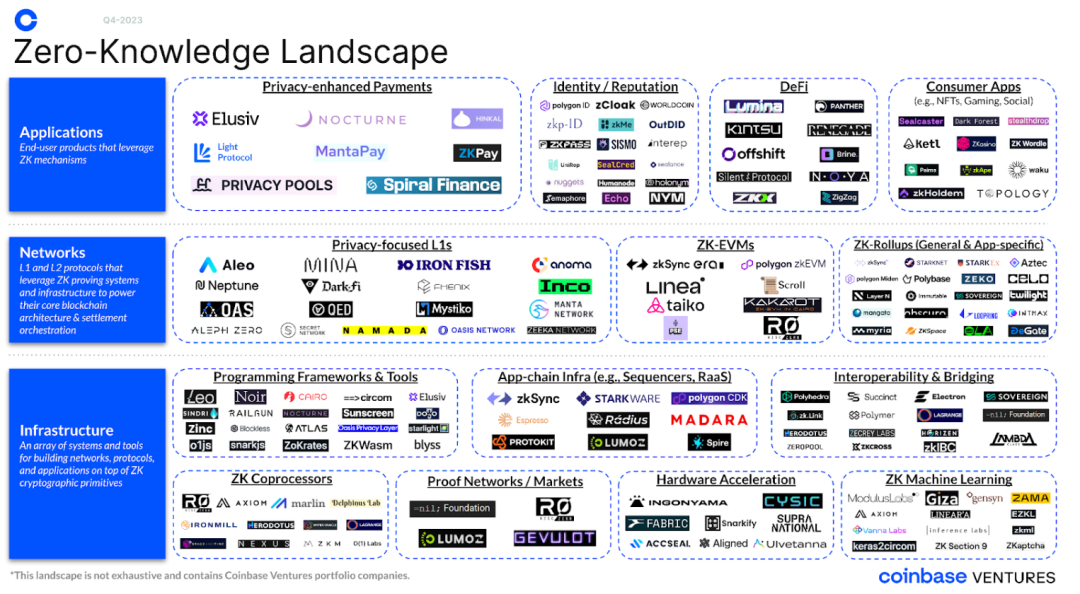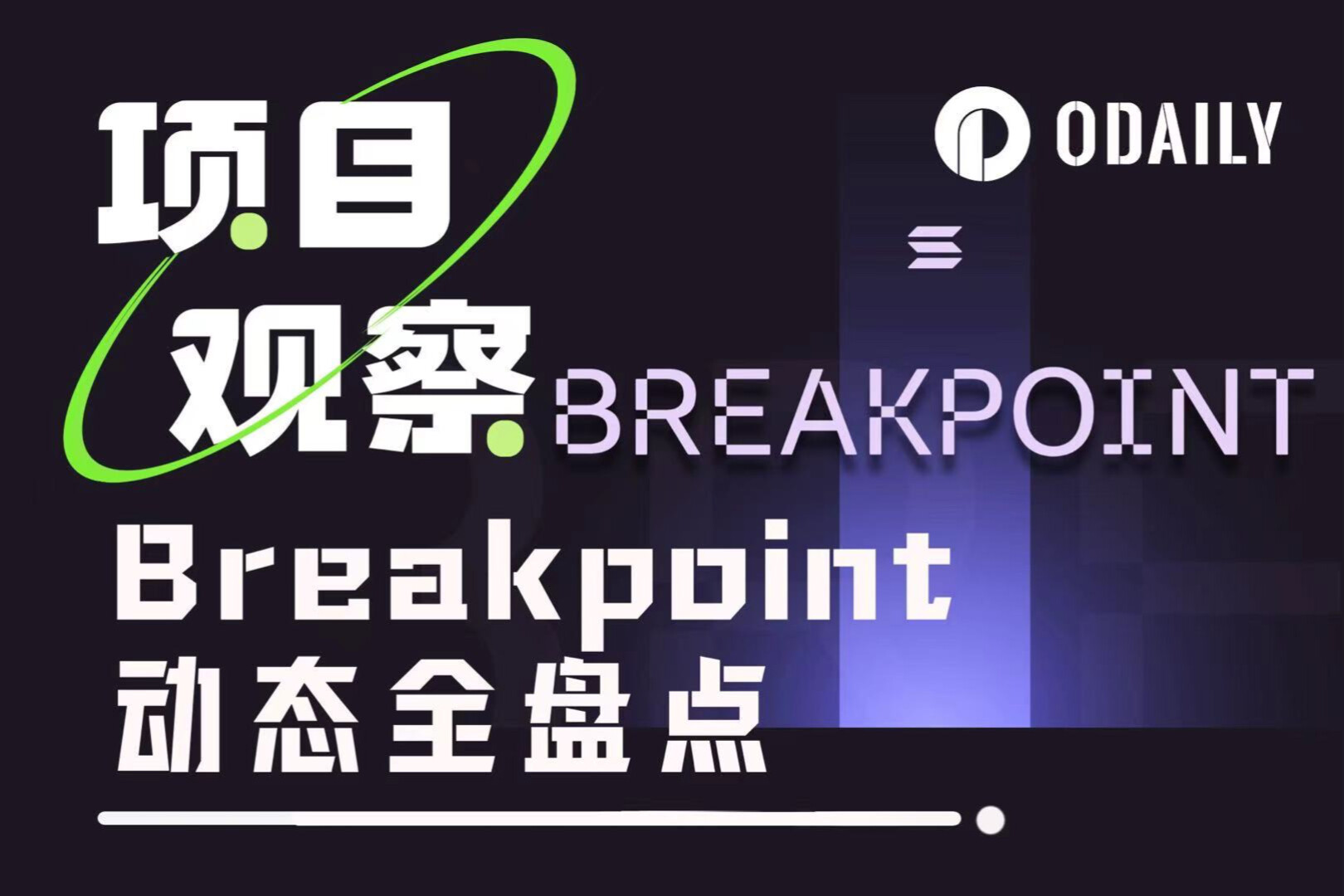Coinbase: Detailed explanation of ZK ecology
Original title: Understanding the Zero-Knowledge Landscape
Original author: Jonathan King

Zero-knowledge proofs (ZKP) and the resulting technologies are a breakthrough area in cryptography and are largely seen as the ultimate goal of blockchain design concepts.
Today, ZKP is increasingly becoming one of the most promising solutions to open problems in web3, including: 1) blockchain scalability, 2) privacy-preserving applications, and 3) no need Trusted interoperability.
In 2023, ZK Technology will invest more than $400 million, focusing mainly on the scalability of the Ethereum L1 or L2 protocol layer, as well as emerging infrastructure and developer tools.
The ZK ecosystem can be divided into 3 layers: 1) Infrastructure (i.e., the tools or hardware used to build protocols or applications on top of ZK primitives), 2) Network (i.e., the L1 and L2 protocols that utilize the ZK proof system), and 3 ) application (that is, user terminal products that utilize the ZK mechanism).
Although still in its early stages, the rapid development of the ZK ecosystem promises to usher in a new era of secure, private, and scalable blockchain solutions.

Zero-knowledge proofs (ZKP) and the resulting technologies are largely seen as the ultimate goal of blockchain design, particularly as it relates to providing a solution for on-chain applications to verify with minimal trust assumptions information. Essentially, zero-knowledge proof is a cryptographic technique that allows one party (called the prover) to prove to another party (the verifier) that a computation is valid without exposing any of the underlying data used to create the computation. ZKP originated in 1985. Currently, with the latest advancements in software tools and hardware, ZK has overcome decades of lag and evolved from theory to practice.
Today, ZKP provides promising solutions to web3’s biggest challenges, including:
Blockchain Scalability: One of the biggest challenges facing Ethereum L1 is scalability. However, the emergence of L2 networks can enable faster and cheaper transactions without compromising the security or decentralized properties of Ethereum. While Optimistic Rollups still dominate given their higher EVM compatibility and developer friendliness, the adoption of ZK Rollups is growing steadily. ZKP helps aggregate complex computations off-chain, thereby enhancing L2 designs for fast and cost-effective on-chain verification and settlement.
Privacy protection applications: To date, privacy work in blockchain environments has been mainly limited to obfuscating transactions. However, researchers are gradually working towards achieving complete transaction anonymity and privacy on public blockchains. Importantly, novel privacy protection concepts leveraging ZKP are emerging that aim to break the trade-off between protecting user privacy and achieving compliance (i.e., blocking illegal activities).
Trustless interoperability: Existing blockchain interoperability protocols rely on trusted systems (such as multi-signatures or incentivized validator sets). ZKP can help replace cryptoeconomic trust assumptions with cryptographic proofs, opening up new avenues for safer and more robust cross-chain communications. However, among the main applications of ZKP, interoperability is the most emerging area.
According to Messaris deal screener, investment in the ZK field will exceed US$400 million in 2023, with a focus on the scalability of the Ethereum L1/L2 layer and the emerging ZK developer infrastructure. Although ZK is relatively new, its rapidly growing ecosystem is expected to incorporate best practices to enable more secure, private, and scalable blockchain applications. With this framework in mind, let’s take a closer look at the ZK ecosystem layer by layer, exploring key players and emerging concepts.
infrastructure

Any form of ZKP must be written in arithmetic circuit language, which has limited expressions and is complex to convert most blockchain functions into circuit form. Limitations in developer tools and hardware have meant that practical use cases for ZK have only recently begun to make slow progress. Today, we are seeing the emergence of a range of systems and tools that enable developers to build protocols and applications on top of ZK cryptographic primitives.
Programming frameworks and tools:Domain-specific languages (DSLs), such as Leo, Noir, Cairo, and o 1 js, are used in specific L1/L2 ecosystems (such as Aleo, Aztec, Starkware, and Mina). In addition, general frameworks such as Elusiv and Hinkal are emerging to allow developers to define specific standards for how to mask transaction data on-chain but use ZKP for verification. Adoption is expected to grow to meet the latent demand from developers and end users for ZK-powered applications
ZK coprocessor:The ZK Coproessor provides developers with cost-effective and trustless off-chain computing capabilities while eliminating the need for developers to use complex ZK-related components in their technology stacks. Teams such as RiscZero, Axiom, and Herodotus provide verifiable computing platforms that can generate proofs proving the execution and validity of arbitrary programs, or enable smart contracts to store, access, and verify historical data on-chain without imposing additional trust assumptions . Over time, the ZK coprocessor will become key to increasingly evolving on-chain applications.
Proof Networks and Marketplaces:Today, most ZK networks and protocols rely on a centralized attestation process. As ZK adoption continues to grow, we expect more teams will look to decentralized proof layers to increase their liveness and censorship resistance. Emerging proof networks and marketplaces, such as =nil Foundation, RiscZero, Gevulot, and Lumoz, aim to allow applications to outsource their proof mechanisms to third-party operators, thereby reducing the overhead of operating on ZKP infrastructure.
Hardware Acceleration:ZKPs are expensive and computationally intensive to generate due to the extensive mathematical operations required. However, we are seeing significant progress in the use of specialized hardware such as Field Programmable Gate Arrays (FPGAs) and Application Specific Integrated Circuits (ASICs), which help reduce proof generation and verification times. Specialized hardware providers such as Ingonyama, Cysic and Fabric are currently at the forefront of providing FPGAs and ASICs for ZK proof systems, and we expect innovation and investment in ZK hardware designs to continue to increase in the future.
Application chain infrastructure:Rollup-as-a-service (RaaS) providers such as Spire, ProtoKit, and Lumoz provide developers with low-code tools that leverage the ZK proof mechanism to build, test, and deploy general or application-specific L2/L3 chains. In terms of sequencers, the infrastructure provided by Espresso, Radius, and Madara is used to accept users transactions, determine their order, and publish blocks to the L1 consensus layer and data availability layer. We believe that the next generation of Ethereum scalability will be powered by modular L2 Rollups stacks, which will likely create demand for these providers in the short to medium term.
Interoperability and bridging:Bridge systems are becoming more trust-minimizing as they remove user dependence on humans (e.g., multisig or incentivized validator sets) and replace trust with code (e.g., light clients, relays, and ZKPs). Teams like Polyhedra, Lambda Class, and Polymer Labs are exploring this topic. Among the major applications of ZKP, interoperability is the most emerging, but as access to ZK primitives accelerates, we expect to see more innovation in bridging design concepts.
ZK Machine Learning (ZKML):ZKML is a cutting-edge field in cryptography that focuses on using ZKP to prove the correctness of on-chain machine learning (ML) model reasoning. By adding machine learning capabilities, smart contracts can become more autonomous and dynamic, allowing them to make decisions based on real-time on-chain data and adapt to a variety of scenarios, including ones that may not have been anticipated when the contract was originally created. Teams like Modulus Labs, Giza, Zama, and others are pioneering unique ZKML use cases that may open up our imagination to provide synergistic balance at the intersection of artificial intelligence and cryptography.
network

Some blockchains face limitations in handling high transaction volumes, resulting in slower transaction times and increased costs during peak demand periods. Additionally, popular blockchains such as Bitcoin, Ethereum, and Solana are all built on open public ledgers, but their lack of privacy has raised concerns among mainstream players who may require complete transaction privacy and anonymity . With the emergence of ZK proof infrastructure, new L1 and L2 networks are emerging to solve issues related to blockchain scalability and on-chain privacy.
Privacy-focused L1:Emerging L1 networks such as Aleo, Mina, and IronFish offer privacy-first smart contract capabilities powered by ZKP to provide application-level privacy for dapps within their respective ecosystems. L1 networks such as Fhenix and Inco use Fully Homomorphic Encryption (FHE), allowing developers to write private smart contracts and perform calculations on top of encrypted data, thereby achieving complete transaction anonymity and privacy. Given that many of the L1s mentioned above are going through incentivized testnets and require developers to learn new programming languages, it may take 1-2 years to achieve mass adoption and value capture.
ZK-EVM:ZK-EVM utilizes zero-knowledge proofs to provide cryptographic proofs for Ethereum-like transaction execution. There are different types of ZK-EVM, such as zkSync Era, Polygon zkEVM, Linea, Scroll, and Taiko, each with different design tradeoffs between EVM compatibility and performance (i.e., proven time to production). We expect continued innovation in this space to scale Ethereum and Ethereum-based ZK-rollups.
ZK-Rollups:ZK-Rollup is an L2 scaling solution that moves computation off-chain and uses ZKP to prove on-chain state changes. Aztec, for example, provides a “privacy engine on Ethereum” designed to encrypt transaction data while ensuring transaction costs are kept low. While Zeko is an upcoming ZK-rollup stack built on Mina that enables applications to recursively verify and combine with each other, while ImmutableX and LayerN are application-specific for gaming and high-performance DeFi use cases respectively. ZK-rollup. Although Optimistic-based Rollups account for nearly 90% of the total L2 market share, the demand for ZK-rollups will increase as the underlying technology becomes more accessible.
application

On top of the ZK infrastructure and network layers are an emerging set of end-user applications that leverage ZKP for on-chain payments, identity, private yet compliant DeFi and consumer use cases.
Teams like Elusiv provide user-friendly interfaces for private payments and DeFi transactions by masking addresses, while also employing compliance mechanisms to decrypt transactions from identified illicit actors. On the identity side, zCloak, ZKPass, and zkp-ID employ ZKP, allowing users to prove verifiable data to third parties without exposing personal information.
DeFi protocols such as Lumina and Panther focus on building private and compliant decentralized exchanges. Renegade uses multi-party computation MPC and ZK to provide dark pool trading, an on-chain trading venue that hides the order book and allows large institutions or whale traders to execute orders without exposing them to the wider market. broadcast.
Consumer applications such as Sealcaster and Dark Forest utilize ZKP in social and gaming applications to protect user identities and gaming strategies from other on-chain participants.
The future of ZK
The future of ZK primarily involves speed-first novel zero-knowledge proof designs, reduced hardware requirements, improved developer tools, and support for decentralized proof generation. While both Optimistic and ZK scaling solutions are used to verify aggregated transactions, each solution has associated design trade-offs between security, latency and computational efficiency, but in the medium to long term we will see that both The convergence of stacks to accommodate a diverse range of on-chain applications. Finally, the ZK application layer is currently in its infancy, but will likely continue to grow as end-user demand for privacy protection on public blockchains grows. Additionally, it is worth noting that ZK research has primarily been explored in the context of Ethereum. However, emerging concepts such as Solana’s Token 22 program with Confidential Transfers (such as privacy features that leverage ZKP crypto token balances and SPL token transfer amounts) demonstrate ZK’s adaptability and potential outside of specific ecosystems.
In summary, ZK’s transformative potential is emerging, heralding improvements in the security, privacy, and scalability of blockchain solutions. In the ZK space, Coinbase Ventures is investing in emerging ZK developer infrastructure (such as co-processors, proof markets, application chain infrastructure) and applications (such as private payments and DeFi) that can unlock new forms of on-chain utility, and be led by a team with top ZK cryptography talent (which will be a rare and small talent pool). If youre involved in building these areas, wed love to hear from you - JKs DMs are open!
statement
The following Coinbase Ventures portfolio companies appear above: Aleo, Anoma, Aztec, Consensys, Espresso, Elusiv, Mina, Polygon, Polymer Labs, Starkware, Sunscreen, zCloak, zkLink, zkSync



